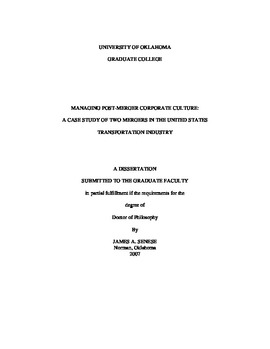| dc.contributor.advisor | O'Hair, Dan, | en_US |
| dc.contributor.author | Senese, James A. | en_US |
| dc.date.accessioned | 2013-08-16T12:20:27Z | |
| dc.date.available | 2013-08-16T12:20:27Z | |
| dc.date.issued | 2007 | en_US |
| dc.identifier.uri | https://hdl.handle.net/11244/1123 | |
| dc.description.abstract | One company proactively sought to recognize and adopt the best cultural characteristics of both pre-merger partners. The other company chose to rapidly integrate two competitors with an expectation that the culture of the acquired organization would be assimilated into the culture of the new owner. | en_US |
| dc.description.abstract | The number and value of mergers and acquisitions involving a United States company continue to grow at record rates. The excitement about doing a merger or acquisition is driven by the anticipation of financial success due to reduced competition, operational synergies, and access to larger customer bases. The dark side of mergers and acquisitions, however, is that two-thirds of them either fail or under perform expectations. Although blame is often placed on financial considerations or unrealistic business plans, there has been a recent interest in how the human side of mergers and acquisitions may affect their ultimate success. | en_US |
| dc.description.abstract | The creation of these case studies has contributed to the body of knowledge by providing the rationale, results, and consequences that might be analogous to other organizations considering a post-merger culture change. The two mergers selected for this research represent the extreme ends of the change spectrum. The case studies were written based on 23 personal interviews with current and previous employees in a range of positions at both companies. The research also relies heavily on document examination, reference to published materials, and observations of the companies in their natural setting. | en_US |
| dc.description.abstract | Since no two mergers are alike, this case study research provides information that may be of value to those considering a merger or acquisition. Merger participants should take into account such factors as the workforce size, geographical distribution, strength of collective bargaining agreements, and tenure of employees when making post-merger culture change decisions of their own. | en_US |
| dc.description.abstract | In the second case, no underlying development strategy was used to guide the process. Operating problems attributable to the disregard of job skills developed within months. Many employees who resisted were given an exit opportunity causing a knowledge deficit in territories germane to the acquired company. Severe and costly service disruptions resulted which took years for the company to recover from. | en_US |
| dc.description.abstract | This dissertation examines and discusses---in case study format---the different approach the leadership of two organizations took to manage corporate culture in their transportation industry mergers. | en_US |
| dc.description.abstract | The second case studies the merger of two competitors that sought to build a larger end-to-end network. Using the Harrison and Stokes (1992) descriptors, the acquired company in this example had an achievement type culture while the acquiring company had and still has a role type culture. In this case the post-merger culture change (P. M. C. C.) methodology consisted simply of requiring that the acquired company adopt the rules and practices of the acquiring company. | en_US |
| dc.description.abstract | Using descriptors coined by Harrison and Stokes in 1992, the first case study examines a merger that featured the combination of a company with a power culture with a competitor that had a support culture. According to senior management, both cultures contributed to the financial success of the predecessor companies. With the approaching merger, however, the leadership team recognized that a clash of the different values, attitudes, and driving forces could be detrimental to the new company. | en_US |
| dc.description.abstract | One topic often disregarded when a merger is planned is how the corporate cultures of the two companies will react with each other when the companies are brought together. Since every organization has a unique culture, it is possible that the two cultures could clash and undermine the benefits of the merger by reducing productivity, disrupting operations, disturbing the supply chain, or alienating customers. | en_US |
| dc.description.abstract | The post-merger culture change (P.M.C.C.) at one company relied on the identification and adoption of best practices from both predecessor companies. That merger has been declared to be successful by senior management based on levels of employee satisfaction, profitability, and share price as indicators. | en_US |
| dc.format.extent | xvi, 138 leaves : | en_US |
| dc.subject | Southern Pacific Company. | en_US |
| dc.subject | Transportation Mergers Case studies. | en_US |
| dc.subject | Business Administration, Management. | en_US |
| dc.subject | Union Pacific Railroad Company. | en_US |
| dc.subject | Corporate culture. | en_US |
| dc.subject | Thrifty Car Rental. | en_US |
| dc.subject | Consolidation and merger of corporations Case studies. | en_US |
| dc.subject | Dollar Rent A Car Systems Inc. | en_US |
| dc.title | Managing post-merger corporate culture: A case study of two mergers in the United States transportation industry. | en_US |
| dc.type | Thesis | en_US |
| dc.thesis.degree | Ph.D. | en_US |
| dc.thesis.degreeDiscipline | Department of Communication | en_US |
| dc.note | Source: Dissertation Abstracts International, Volume: 67-11, Section: A, page: 4256. | en_US |
| dc.note | Adviser: Dan O'Hair. | en_US |
| ou.identifier | (UMI)AAI3242156 | en_US |
| ou.group | College of Arts and Sciences::Department of Communication | |
